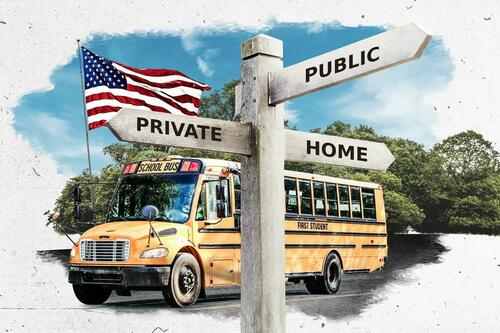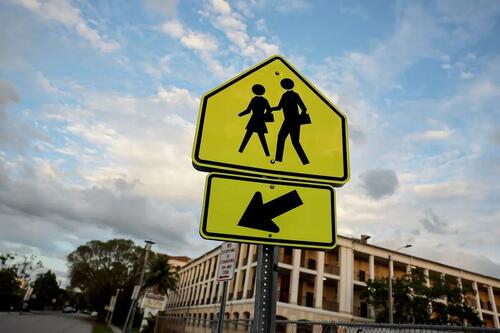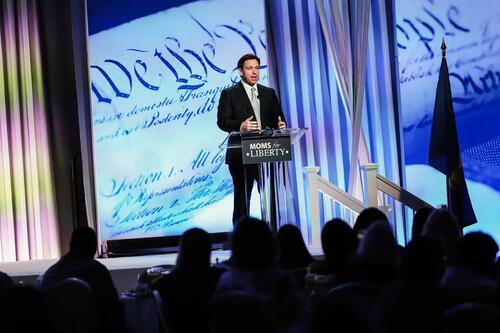
Authored by Jackson Elliott via The Epoch Times (emphasis ours),
Florida mother of five Nicole Andrews puts it bluntly when asked why she sends her children to a charter school instead of the assigned public school for their community.

She “absolutely, desperately” wants her youngsters in charter school because it has “a different culture,” she told The Epoch Times. Other parents feel the same way.
“There is a different level of expectation and rigor” at St. Johns Classical Academy, Ms. Andrews said.
“There is a different value set. There is a different mindset as to the value of education.”
There’s also a waiting list for slots at both of the school’s campuses, in Fleming Island and Orange Park, in the northeastern area of the state. The school opened in August 2017 and is free to attend.
Ms. Andrews is among hundreds of thousands of parents across America who are making the switch from public schooling to some other form of education as part of a nationwide rallying cry for “school choice.”
In general, school choice allows parents to request that the taxpayer dollars assigned to their child for education be used for other options. That could mean transferring the money to a charter school, using it for tuition for a private school, or taking it as reimbursement for homeschooling expenses.
Recently, many states have adopted legislation to put into place some form of school choice program.
Presently, 10 states have what’s known as universal school choice, meaning it’s open to any child. Those states are Arizona, Arkansas, Florida, Iowa, Ohio, Oklahoma, Utah, West Virginia, Indiana, and North Carolina.
Many other states have a school-choice program for at least some children, with a range of criteria to qualify. Some serve children in a low socio-economic demographic. Others offer assistance to children with learning disabilities or other special needs.
In some states, programs allow public dollars set aside for each child’s education to follow a child leaving public school. Then, that money can be used for tuition for private schools. Or the money may be transferred to fund that child’s slot at a charter school.
Charter schools are publicly funded, but operate independently from the public school system.
In some states, school choice means that even parents who choose to homeschool can use public dollars allotted to educate their children on things like curriculum and tutoring.
The options vary from state to state. And the amount of public money set aside for each child usually ranges from between $5,000 to $8,000, depending on the state.

The Department of Education reports that the government spent an average of $14,295 per student in public schools from elementary through 12th grade in the 2020–2021 school year.
Many conservatives support the idea of school choice, saying it will force failing public schools to improve or lose students. And more importantly, they say, those failing schools will lose the funding they receive to educate the children who leave.
Some parents who’ve previously paid for their children’s private school tuition or homeschooling expenses on their own, with no government assistance, say school-choice programs bring about much-needed fairness.
That’s because—by paying taxes—those parents contribute to the public money used to pay for public education. But they’ve received none of the benefit, and still have to cover the costs of their children’s education.
There’s also a strong lobby movement that’s against school choice.
Public schools are deeply connected to some of the most potent activist groups in American society—the teachers’ unions.
And though polls show parents strongly favor school choice, unions are adamant in their opposition.
“Vouchers take scarce funding from students in public schools and give those resources to unaccountable private schools,” the National Education Association (NEA) states on its website.
The NEA also say that vouchers, used in school choice programs, don’t support disabled students, don’t protect the human and civil rights of students, and “exacerbate segregation.”
The American Federation of Teachers (AFT) states on its website that evidence “does not support the argument that vouchers and other methods to establish a market system of schools will improve school or student performance.”
The NEA and AFT are two of America’s largest unions, with a combined total of more than 4.7 million members.
The Epoch Times contacted both unions but received no response by publication time.
Parents told The Epoch Times they hope school choice and the competition it creates will eventually make education better for everyone.
“I think that once you take an institution, and make it a public institution, and have large governmental control over it, you’re going to lose some quality,” Ms. Andrews said.
“Lord willing, public institutions will have to change their game a bit, and everyone will benefit.”
School Choice Options
School-choice programs vary widely.
Some states, such as Indiana, Iowa, and West Virginia, offer the use of an education savings account (ESA). An ESA gives money to parents in a bank account, and funds can be spent on educational expenses, such as school tuition, textbooks, private tutoring, and school supplies.
Other states, such as Florida, Arkansas, and Wisconsin, offer vouchers, which take the money set aside to educate children in public schools and allow parents to spend it on tuition for private schools. Voucher money also can be transferred to a charter school.

Still others offer tax-credit scholarships. These allow taxpayers to receive tax credits when they donate to nonprofits that provide scholarships to private schools. Parents can apply for these scholarships for their children.
In other states—including Alabama, Illinois, and Louisiana—qualifying parents receive tax credits for paying for their children’s private schooling.
Alaska offers state funding for some private schooling through “correspondence study programs.” These programs allow a student to receive an individualized learning program and options normally unavailable in public schools, such as resources from religious groups or private tutoring.
Many states allow families to open college savings investment accounts to help with educational expenses. These accounts allow families to deposit pre-tax money into investment accounts. Recently, some states have changed the rules on these accounts so parents can spend some of this money on childhood education expenses.
In 1990, school-choice options like these were practically nonexistent.
As of 2023, America had about 700,000 school-choice programs, according to statistics from EdChoice, an Indiana nonprofit that promotes school choice.
With so many Americans increasingly taking advantage of school-choice options, this may be just the beginning of a movement that would fundamentally reshape American public education, EdChoice president Robert Enlow told The Epoch Times.
“This year has been the year of universal choice, where we now have 10 states that basically allow every single student in the state to attend whatever setting works best with them—public, private, charter, at home, or online,” Mr. Enlow said. “We’re really excited about that growth.”
For homeschooling parents, receiving state money can make a huge difference, homeschooling mother Kimberly Ebbers told The Epoch Times.
She quit her job to give her three sons an education at home. She’s been teaching them for 22 years.
“In the beginning, we didn’t take vacations and buy new clothes and eat out,” said Ms. Ebbers, who lives in Florida. “We sacrificed so that I could stay home.
“It was just important to us to be with our children and for our children to be with each other.”
In 2023, Florida passed legislation allowing for universal school choice, which means even homeschooling children are eligible for funding from the state for educational expenses.

But surprisingly, the Ebbers family isn’t interested in using the state’s money.
State money can mean state control over education to some degree, Ms. Ebbers said.
“In the future, it may lead to them choosing our curriculum or other choices like that,” she said.
However, money from the state could be a blessing to families with children with disabilities, she said.
“I do have friends that have kids with special needs that have to have services, like speech pathology, or physical therapy, or occupational therapy. And it’s expensive, going every week to those appointments and paying out-of-pocket costs.”
Florida homeschooling mother of five Michelle Jernigan told The Epoch Times she greatly appreciates new laws that give homeschoolers aid in educating their children.
“I’m very grateful to the state for making it so we’re able to afford things we were never able to afford before for my kids,” Ms. Jernigan said. “And it has made a big difference in their education.”
Read more here...
Authored by Jackson Elliott via The Epoch Times (emphasis ours),
Florida mother of five Nicole Andrews puts it bluntly when asked why she sends her children to a charter school instead of the assigned public school for their community.

She “absolutely, desperately” wants her youngsters in charter school because it has “a different culture,” she told The Epoch Times. Other parents feel the same way.
“There is a different level of expectation and rigor” at St. Johns Classical Academy, Ms. Andrews said.
“There is a different value set. There is a different mindset as to the value of education.”
There’s also a waiting list for slots at both of the school’s campuses, in Fleming Island and Orange Park, in the northeastern area of the state. The school opened in August 2017 and is free to attend.
Ms. Andrews is among hundreds of thousands of parents across America who are making the switch from public schooling to some other form of education as part of a nationwide rallying cry for “school choice.”
In general, school choice allows parents to request that the taxpayer dollars assigned to their child for education be used for other options. That could mean transferring the money to a charter school, using it for tuition for a private school, or taking it as reimbursement for homeschooling expenses.
Recently, many states have adopted legislation to put into place some form of school choice program.
Presently, 10 states have what’s known as universal school choice, meaning it’s open to any child. Those states are Arizona, Arkansas, Florida, Iowa, Ohio, Oklahoma, Utah, West Virginia, Indiana, and North Carolina.
Many other states have a school-choice program for at least some children, with a range of criteria to qualify. Some serve children in a low socio-economic demographic. Others offer assistance to children with learning disabilities or other special needs.
In some states, programs allow public dollars set aside for each child’s education to follow a child leaving public school. Then, that money can be used for tuition for private schools. Or the money may be transferred to fund that child’s slot at a charter school.
Charter schools are publicly funded, but operate independently from the public school system.
In some states, school choice means that even parents who choose to homeschool can use public dollars allotted to educate their children on things like curriculum and tutoring.
The options vary from state to state. And the amount of public money set aside for each child usually ranges from between $5,000 to $8,000, depending on the state.

The Department of Education reports that the government spent an average of $14,295 per student in public schools from elementary through 12th grade in the 2020–2021 school year.
Many conservatives support the idea of school choice, saying it will force failing public schools to improve or lose students. And more importantly, they say, those failing schools will lose the funding they receive to educate the children who leave.
Some parents who’ve previously paid for their children’s private school tuition or homeschooling expenses on their own, with no government assistance, say school-choice programs bring about much-needed fairness.
That’s because—by paying taxes—those parents contribute to the public money used to pay for public education. But they’ve received none of the benefit, and still have to cover the costs of their children’s education.
There’s also a strong lobby movement that’s against school choice.
Public schools are deeply connected to some of the most potent activist groups in American society—the teachers’ unions.
And though polls show parents strongly favor school choice, unions are adamant in their opposition.
“Vouchers take scarce funding from students in public schools and give those resources to unaccountable private schools,” the National Education Association (NEA) states on its website.
The NEA also say that vouchers, used in school choice programs, don’t support disabled students, don’t protect the human and civil rights of students, and “exacerbate segregation.”
The American Federation of Teachers (AFT) states on its website that evidence “does not support the argument that vouchers and other methods to establish a market system of schools will improve school or student performance.”
The NEA and AFT are two of America’s largest unions, with a combined total of more than 4.7 million members.
The Epoch Times contacted both unions but received no response by publication time.
Parents told The Epoch Times they hope school choice and the competition it creates will eventually make education better for everyone.
“I think that once you take an institution, and make it a public institution, and have large governmental control over it, you’re going to lose some quality,” Ms. Andrews said.
“Lord willing, public institutions will have to change their game a bit, and everyone will benefit.”
School Choice Options
School-choice programs vary widely.
Some states, such as Indiana, Iowa, and West Virginia, offer the use of an education savings account (ESA). An ESA gives money to parents in a bank account, and funds can be spent on educational expenses, such as school tuition, textbooks, private tutoring, and school supplies.
Other states, such as Florida, Arkansas, and Wisconsin, offer vouchers, which take the money set aside to educate children in public schools and allow parents to spend it on tuition for private schools. Voucher money also can be transferred to a charter school.

Still others offer tax-credit scholarships. These allow taxpayers to receive tax credits when they donate to nonprofits that provide scholarships to private schools. Parents can apply for these scholarships for their children.
In other states—including Alabama, Illinois, and Louisiana—qualifying parents receive tax credits for paying for their children’s private schooling.
Alaska offers state funding for some private schooling through “correspondence study programs.” These programs allow a student to receive an individualized learning program and options normally unavailable in public schools, such as resources from religious groups or private tutoring.
Many states allow families to open college savings investment accounts to help with educational expenses. These accounts allow families to deposit pre-tax money into investment accounts. Recently, some states have changed the rules on these accounts so parents can spend some of this money on childhood education expenses.
In 1990, school-choice options like these were practically nonexistent.
As of 2023, America had about 700,000 school-choice programs, according to statistics from EdChoice, an Indiana nonprofit that promotes school choice.
With so many Americans increasingly taking advantage of school-choice options, this may be just the beginning of a movement that would fundamentally reshape American public education, EdChoice president Robert Enlow told The Epoch Times.
“This year has been the year of universal choice, where we now have 10 states that basically allow every single student in the state to attend whatever setting works best with them—public, private, charter, at home, or online,” Mr. Enlow said. “We’re really excited about that growth.”
For homeschooling parents, receiving state money can make a huge difference, homeschooling mother Kimberly Ebbers told The Epoch Times.
She quit her job to give her three sons an education at home. She’s been teaching them for 22 years.
“In the beginning, we didn’t take vacations and buy new clothes and eat out,” said Ms. Ebbers, who lives in Florida. “We sacrificed so that I could stay home.
“It was just important to us to be with our children and for our children to be with each other.”
In 2023, Florida passed legislation allowing for universal school choice, which means even homeschooling children are eligible for funding from the state for educational expenses.

But surprisingly, the Ebbers family isn’t interested in using the state’s money.
State money can mean state control over education to some degree, Ms. Ebbers said.
“In the future, it may lead to them choosing our curriculum or other choices like that,” she said.
However, money from the state could be a blessing to families with children with disabilities, she said.
“I do have friends that have kids with special needs that have to have services, like speech pathology, or physical therapy, or occupational therapy. And it’s expensive, going every week to those appointments and paying out-of-pocket costs.”
Florida homeschooling mother of five Michelle Jernigan told The Epoch Times she greatly appreciates new laws that give homeschoolers aid in educating their children.
“I’m very grateful to the state for making it so we’re able to afford things we were never able to afford before for my kids,” Ms. Jernigan said. “And it has made a big difference in their education.”
Read more here…
Loading…





